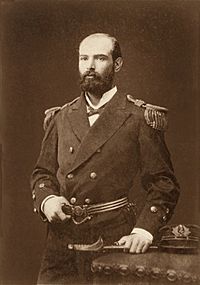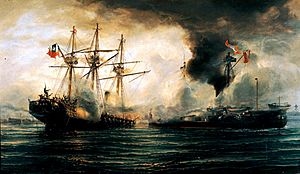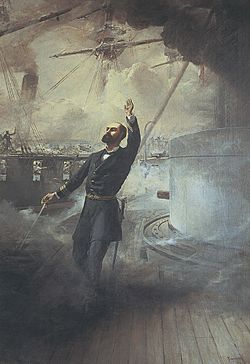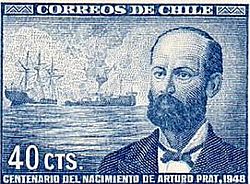Arturo Prat facts for kids
Quick facts for kids
Arturo Prat
|
|
|---|---|

Photography by Arturo Prat.
|
|
| Born | April 3, 1848 Ninhue, Chile |
| Died | May 21, 1879 (aged 31) Off Iquique, Peru (present-day Chile) |
| Allegiance | |
| Service/ |
Chilean Navy |
| Years of service | 1861–1879 |
| Rank | Frigate captain |
| Commands held | |
| Battles/wars |
|
| Spouse(s) | Carmela Carvajal |
| Children | Carmela de la Concepción, Blanca Estela and Arturo Héctor |
| Other work | Lawyer, teacher and secret agent |
Arturo Prat Chacón (born April 3, 1848 – died May 21, 1879) was a brave Chilean lawyer and navy officer. He is famous for his heroic actions during the Battle of Iquique in the War of the Pacific.
During his time in the navy, Prat took part in several important sea battles. These included the Battle of Papudo in 1865 and the Battle of Abtao in 1866. After his death, his name became a powerful symbol for Chilean forces. Today, Arturo Prat is seen as a great national hero in Chile.
Many places in Chile are named after him, like squares, streets, and buildings. Four major Chilean warships have also carried his name. These include a cruiser, a destroyer, and a frigate. Even a research station in Antarctica, Arturo Prat Station, and the Chilean Naval Academy are named in his honor. You can also see his picture on the 10,000 Chilean peso banknote. In 1984, Arturo Prat University was founded in Iquique, where his famous battle took place.
Contents
Arturo Prat was born on April 3, 1848, in south-central Chile. He was the oldest of five children. His parents were Agustín Prat del Barril and Rosario Chacón Barrios. The name Prat comes from a region in Spain called Catalonia.
At just 10 years old, on August 28, 1858, Arturo joined the Naval Academy. He received a scholarship from President Manuel Montt. Another scholarship went to his friend, Luis Uribe. Both boys were like brothers, as they shared the same helper, Don Jacinto Chacón.
The academy was run by French officers. Arturo and Luis were part of a special group called the "class of the heroes." This group also included future naval leaders like Carlos Condell and Juan José Latorre.
In 1859, Arturo began his training at sea. He learned how to sail and handle ship equipment. He also practiced seamanship and artillery. In January 1860, he first boarded the ship Esmeralda. He continued his training, learning about boarding and combat. By July 1861, he was the top student in his class. He became a "midshipman without examination."
Prat showed his bravery early on. In October 1861, a French ship carrying explosives caught fire in Valparaíso Bay. The Esmeralda sent boats to help. Prat steered one of these boats and fought the fire for two hours.
War with Spain
On July 21, 1864, Arturo Prat passed his tests to become an "examined midshipman." That year, a war started between Chile and Spain. This war was Prat's first real combat experience.
Prat was serving on the Esmeralda. The ship's commander, Juan Williams Rebolledo, planned to capture a Spanish ship called Covadonga. The battle of Papudo happened on December 26. The Chilean forces quickly won because they had more firepower. They captured the Covadonga. Because of this victory, all sailors in the battle were promoted. Prat became an ensign, similar to a second lieutenant in the army.
The Spanish fleet wanted to make up for their loss. They sought another fight with the allied navies of Chile, Peru, and Ecuador. This led to the battle of Abtao on February 7, 1866, near Chiloé. Prat was on the Covadonga during this battle. His ship faced heavy Spanish gunfire. There were no deaths on the allied side, while the Spanish had two. The battle ended without a clear winner.
A Young Officer's Career
After the war, Prat traveled a lot by sea. He visited places like the Juan Fernández Islands and Easter Island. In 1868, he went to Peru to deliver aid after an earthquake. He also brought back the remains of a Chilean hero, Bernardo O'Higgins.
On September 9, Prat was promoted to lieutenant. He returned to the Naval School as an instructor. From 1871, he was the Second Commander of Esmeralda. He taught courses like Naval Order, Law, and Naval Tactics. He also helped dock the corvette for four years in Mejillones. In 1873, he became a Graduated Corvette Captain. He worked hard to improve education despite limited resources. He even translated textbooks from French to Spanish.
In May 1875, Prat showed his courage again. A storm hit Valparaíso port. The Esmeralda was in danger of sinking after hitting another ship. Prat, who was on sick leave, rushed back. He and his commander, Luis Alfredo Lynch, swam to the ship. Prat worked tirelessly, tying a rope to the mast to save the ship. He managed to secure it to the beach. Lynch later praised Prat's "unflappable calm in the face of danger."
The Esmeralda needed long and costly repairs. Prat remained loyal to his commander, Lynch, who faced charges but was cleared. In 1876, the Chilean government closed the Naval School. They believed Chile no longer needed naval officers. Prat left the Esmeralda and became an assistant for the Maritime Government of Valparaíso. He was a graduated commander by then. He only returned to a ship when the war started.
Prat as a Lawyer
In 1870, Prat decided to study law. He had always been interested in it. He first studied humanities at the Liceo de Valparaíso. In 1871, he earned his diploma in Philosophy and Humanities. This was needed to study law.
The next year, he began studying Property Law at the University of Chile. He studied while serving on the Esmeralda in Mejillones. He passed his exams in Valparaíso. In 1875, he started working at a law firm. This was a requirement to get his law license.
By July 1876, Prat had passed all his courses. He needed to pass one final exam before judges of the Supreme Court. On July 31, 1876, Prat arrived in his full navy uniform. To his surprise, the judges decided not to hear exams that day. Prat insisted, explaining his limited free time as a naval officer. He convinced the Supreme Court president, Manuel Montt Torres, to hear him. Prat passed his exam and became a lawyer at age 28.
Before his final exam, Prat had already worked on legal cases. He defended an engineer and his friend, Luis Uribe. He won the first case. His friend Uribe was sentenced to jail, but the president later pardoned him.
Prat practiced law for a short time. He mostly helped his family with legal issues. He also worked on naval legal problems. He wanted to be a Navy auditor. He helped improve the navy's legal system. He suggested many changes to the Navigation Law, and many were approved. He also worked to make the promotion system fairer. He wanted it to be based on merit, not connections. Sadly, this new navy code was not published before he died.
Family Life
Engagement and Marriage
Arturo Prat met Carmela Carvajal at parties held by Pedro Chacón. They fell in love. Prat was shy and worried about getting married because he didn't have much money.
When he learned he would be promoted to Corvette Captain, he finally proposed to Carmela in 1873. They were married on May 5, 1873, at the San Agustín de Valparaíso church. Carmela was 22 years old. She had been raised by her siblings after her parents died. Arturo and Carmela had a loving relationship. Prat treated his wife as an equal, which was rare for the time. He even let her manage the family money. He also helped with chores, writing to her: "At every moment I seem to find you exhausted from rocking our daughter, without me being next to you and sharing, albeit a bit, your labors..."
First Happiness and First Tragedy
The newlyweds spent their honeymoon in Quillota. Prat then returned to his navy duties. Carmela soon became pregnant with their first daughter.
However, like Prat's older brothers who died young, their daughter was very frail. Arturo hoped that homeopathy, a type of medicine, would help her. He wrote to Carmela: "Keep using homeopathy for my little daughter and inform me after she is healthy." But it didn't work. The child's health worsened.
Prat was away on duty when his daughter was very ill. He desperately wanted to see her. On December 13, his ship finally arrived. He wrote to his wife: "Later then I will be seeing you, as I will see my little child who I hope is completely healthy..." But his daughter, Carmela de la Concepción, had died a week earlier, on December 5. Prat received a letter from his wife, full of sadness. He later wrote on the letter: "The 5 December, at past 1 hour and 3 minutes after midnight, my daughter Carmela de la Concepción died. This is the letter destined to announce it to me. The sadness it reveals should have made me see, but hope is so sweet."
War of the Pacific

When the War of the Pacific began, Prat was assigned to a desk job. He tried to refuse it, wanting to be on a ship. He was later assigned as an assistant to Rafael Sotomayor Baeza. They were on the armored ship Blanco Encalada. Prat was sent to tell the authorities in Iquique that the Chilean army was blocking their port. He did this bravely, despite the hostile crowd.
Prat was then given command of the Covadonga. On May 3, the Covadonga and the Abtao sailed to Iquique. They arrived on May 10. Later, Prat was given command of the Esmeralda, and Carlos Condell took command of the Covadonga.
On May 16, the Chilean fleet sailed to Callao, Peru. They hoped to surprise the Peruvian warships. But on the same day, the Peruvian monitor Huáscar and the frigate Independencia left Callao. They were going to Arica with supplies. So, the two fleets missed each other.
Battle of Iquique and Prat's Death
It was May 21, 1879, at 6:30 in the morning. The fog cleared, and a lookout on the Covadonga spotted smoke. At first, they couldn't tell what ships they were. But soon, they realized it was the Peruvian warships Huáscar and Independencia.
Condell fired a warning shot to the Esmeralda, which was still anchored. The Peruvian admiral, Miguel Grau Seminario, spoke to his crew. He told them to remember past victories and fight for Peru.
The Esmeralda was an old wooden ship. It weighed 850 tons and had eight cannons. The Huáscar was much stronger. It weighed 1,130 tons and had thick armor. It also had two powerful 300-pound cannons in a rotating turret.
At 8:15 a.m., the first shots were fired. Prat ordered the Esmeralda to move. A shot from Huáscar hit the Esmeralda, killing the surgeon and wounding others. The transport ship Lamar fled south. Condell, on the Covadonga, followed it. Prat wondered why Condell was not following his orders. The Independencia chased the Covadonga.
Prat positioned the Esmeralda close to the coast. This forced the Huáscar to shoot over the Peruvian town, whose people watched the battle. General Buendía, the Peruvian commander in Iquique, placed cannons on the beach. He also sent a warning to the Huáscar that the Esmeralda might have torpedoes. Grau kept his distance and fired for an hour and a half. But his crew was new to the Huáscars cannons, so they missed often. The Chilean crew fired back, but their shots bounced off the Huáscars armor.
Peruvian army cannons on the coast also fired at the Esmeralda. A grenade hit, killing three men. Prat moved the ship slowly, as its engine was faulty. He stopped 1,000 meters from the city. This move showed Grau that the Esmeralda had no torpedoes. Another shot from Huáscar hit the Esmeralda, killing the bugler. The Esmeralda's situation was desperate.
At 11:30 a.m., Admiral Grau decided to end the battle. He ordered the Huáscar to ram the Esmeralda. When the Huáscar crashed into his ship, Prat bravely shouted: "Let's board, boys!" Only two men, Petty Officer Juan de Dios Aldea and Seaman Arsenio Canave, heard him. Prat and Aldea jumped onto the Huáscar. Arsenio slipped and fell. Aldea was shot and badly wounded. Prat continued alone, amazing the Peruvian crew with his courage. Grau ordered his men to capture Prat alive.
Prat reached the enemy deck and moved towards the command tower. But he was hit by a bullet and fell to his knees. Another shot from a sharpshooter killed him.
The Esmeralda's crew watched their captain's sacrifice. When the Huáscar rammed the Esmeralda again, Sublieutenant Ignacio Serrano and ten men boarded the Huáscar. They were attacked by Gatling guns and the Peruvian crew. Serrano was the only survivor, badly wounded. Grau had him taken to the infirmary next to Aldea.
A third ram hit the middle of the Esmeralda. This was fatal. The ship began to sink. No one else could board the Huáscar. Midshipman Ernesto Riquelme fired the last cannon shot as the ship went underwater. Grau and his crew heard shouts of "Long Live Chile! Glory and Victory!" from the sinking ship. It was 12:10 p.m. Grau felt sad about Prat's death and honored him.
After the battle, Grau ordered Prat's body and his men's bodies to be buried in Iquique. He also sent Prat's personal items, like his diary and sword, to his widow, Carmela Carvajal. Grau included a letter praising Prat's bravery and character. Prat and his crew were first buried in Iquique. In 1888, their remains were moved to a crypt under the Heroes of Iquique monument in Valparaíso.
Chile lost an old ship that day. But Prat's heroic death inspired the Chilean people to support the war. This was a key factor in Chile's victory in the War of the Pacific.
See also
 In Spanish: Arturo Prat para niños
In Spanish: Arturo Prat para niños
- Chilean ship Capitán Prat
- Juan de Dios Aldea
Trivia
- "Arturo Prat" is the most common street name in Chile. There are 144 communes with a street named after him. This is more than streets named "Esmeralda" (130), "Manuel Rodríguez" (128), or "Gabriela Mistral" (127).





